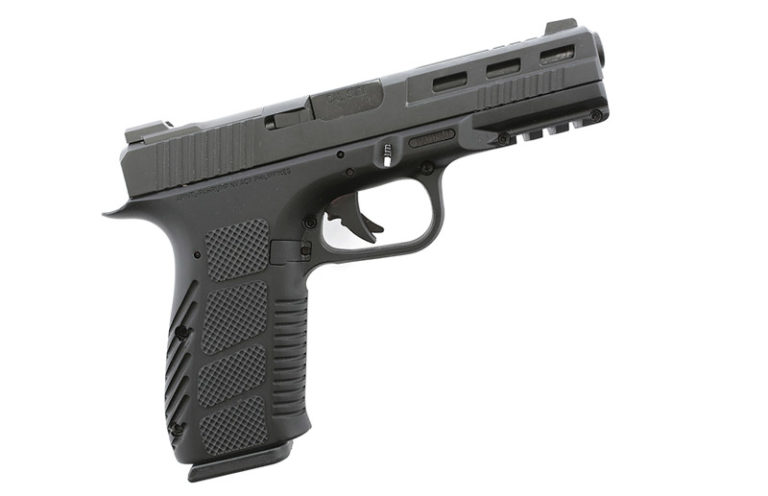
There are a lot of Glock-like 9mm pistols out there, but among them, the all-metal Armscor STK100 stands out as something different.
The marketplace is full of 9mm pistols with capacious magazines. So, why Armscor? Why the STK100? Simple: no polymer. The STK100 not only looks like a Glock (let’s just get the “G word” right out there, shall we?), it uses Glock magazines and even has parts interchangeability with Glock pistols.
And why not?
On the subject of magazines alone, there are probably more Glock magazines extant, and made by a whole host of companies, than there are 1911 magazines. And that’s despite the 70-plus years and two World Wars head start the 1911 had.
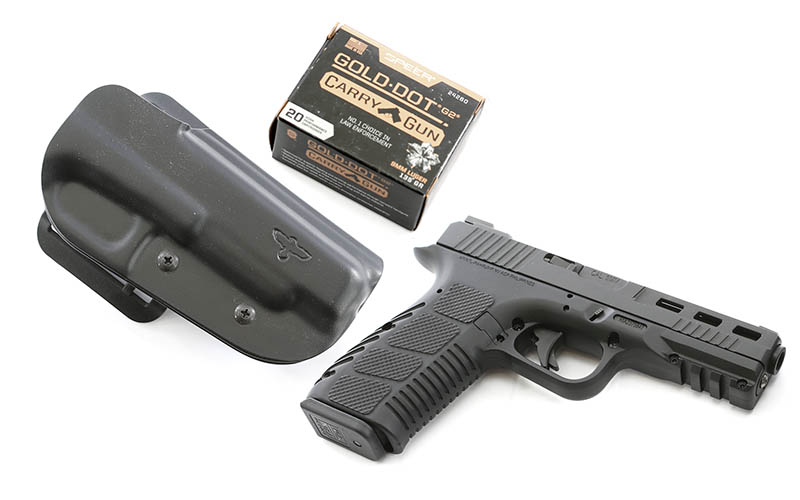
Similar, But Different
So, the STK100 doesn’t use polymer. What does it use, then? Aluminum. And steel. The frame is a pair of aluminum shells. The shells are crafted by milling out 7075 alloy aluminum blocks, and then the two halves are bolted together with six strong fasteners. You can see the screws/bolts holding them. There are two in the grip frame, back where the backstrap would be. There are two across the accessory rail, on the dust cover. And the other two are on the front and rear of the trigger guard.
The interior is steel, a one-piece steel chassis, and you can see that by the serial number poking through the aluminum shell on the right side. This means that the STK100 runs on actual rails, not the four stamped tabs that a Glock uses as bearing surfaces.
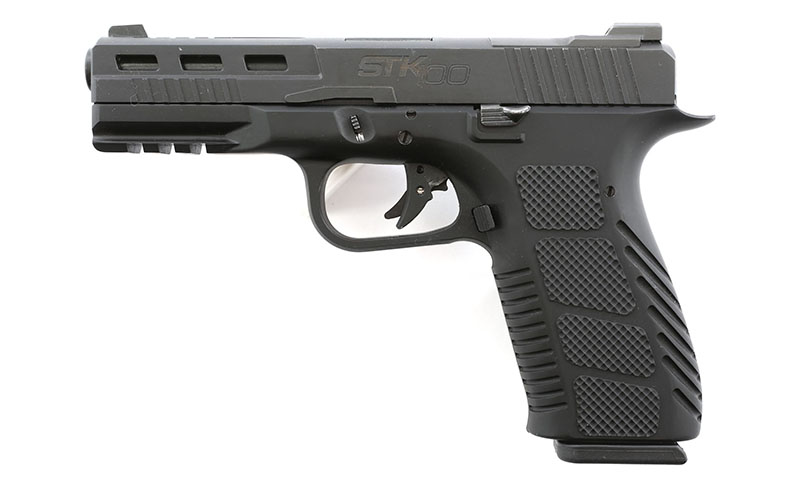
But Armscor didn’t simply clone the G17 in aluminum, because what’s the point? First, the grip is machined to be at the 1911 grip angle, not the Glock angle. Those who have spent time with 1911s will find that the Glock doesn’t point the same. Not that we should be indulging in point-shooting, but when you’re trying to groove in your index on the draw, different angles create problems in transitioning from one pistol to another.
Then, they aggressively machine in nonslip textures. The rear of the grip has diagonal and deep grooves to engage the fleshy part of your hand. The sides have checkerboard panels to give your fingertips purchase and the rest of your hand a grabby surface. The frontstrap has horizontal grooves, and the combination makes for an effective setup.
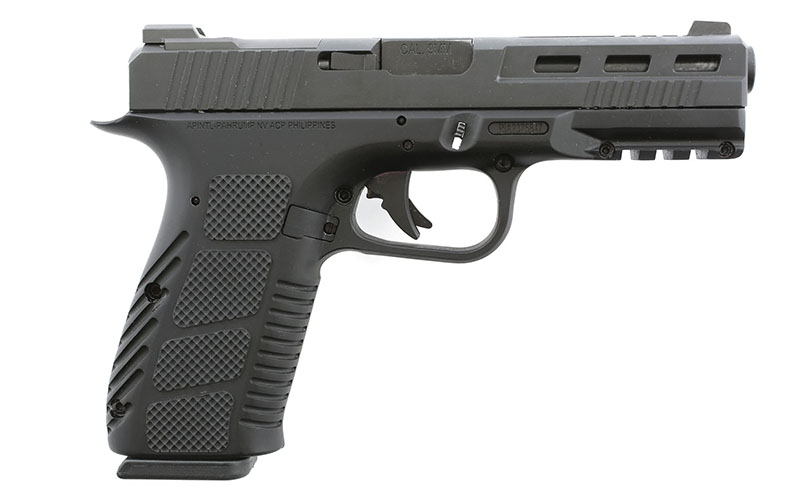
Additionally, when machining the frame halves, Armscor also went and added an extended tang. The stubby little nub of polymer on Glocks doesn’t always do a lot to prevent muzzle lift. There’s just no leverage there for your hand to resist the roll. Well, with the lengthened tang, the STK100 does a much better job. And the greater density of aluminum, compared to polymer, also helps here.
The G17 (which the STK100 is the clone of) is listed as weighing 22 ounces. The STK100 tips the scales (OK, it flexes the torsion bar in my electronic scale) at 28 ounces. Now, 6 ounces may not seem like much, but it’s not in the reciprocating mass of the system, and therefore acts as dead weight to resist inertia. It helps.
Also helping is the slide. The block Glock slide has been improved by Armscor. First, they rounded the edges and corners, so it isn’t so blocky, and that shaves off some weight. Then, they machined clearance slots in the slide, forward of the chamber area, to take more weight out. The top and sides get some cosmetic sculpting, and the front gets some cocking serrations on the widest part. The reduced weight means there’s less reciprocating mass and less to slam to a halt at the rear end of the cycle. With less bottoming-out weight, there’s less impulse to drive the muzzle rise component of recoil. This was noticeable in test-firing.
The sights also get upgrades. The front is the now-standard (for Glocks, anyway) blade set in an oval socket and fastened by a hex-headed screw from underneath. Anyone who has spent any time with Glocks knows that you check this first before shooting your new pistol. The tiny threads (I swear there are something like 60-70 tpi in there) can’t muster a lot of torque to tighten, so Loctite is definitely your friend here. No slam on Armscor, that’s just the design we all have to use.
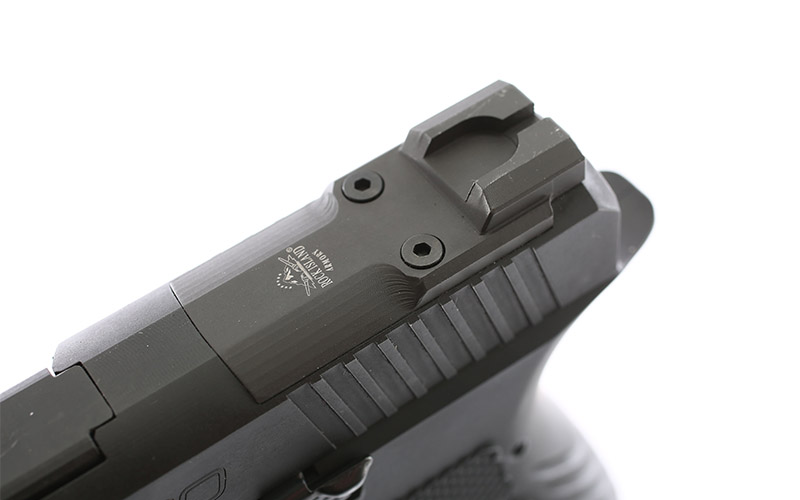
The rear sight is part of a removable plate that permits the installation of a red-dot optic. The plate, when removed, takes the rear sight with it, which to me is a small oversight, as there’s room to have the rear sight stay and still mount a red-dot. The footprint is set up for the Shield sights, and all the other red-dots that use the same screw pattern and base size and shape, which is a lot of them. I would’ve tested the STK100 with a red dot, but every single one of my red-dots of that pattern were already on something else being tested. But I did remove the plate and found the fit to be quite tight, which bodes well for having a red-dot fit and stay in place.
The sample STK100 came with a pair of KCI magazines, which are Glock clones made in Korea. I checked the fit with a fistful of Glock mags (they all fit) and Magpul and ETS mags as well. All fit, and all that were designed to drop free did so when required. I have some crusty old original Glock mags, back before American shooters made it clear they didn’t want “won’t drop” magazines. Those fit and functioned, but they wouldn’t drop free. They never were intended to, so I’m neither surprised nor disappointed.
How’s it Shoot?
Test-firing was … interesting. First up, the weight and its distribution, combined with the grip tang, does a great job of keeping muzzle rise under control. Even with the +P ammo, it wasn’t any big deal to just hammer the various steel plates, falling or otherwise.
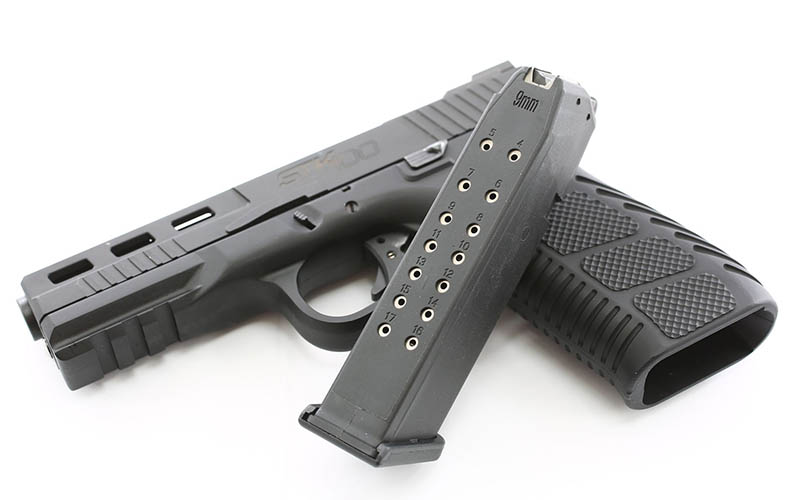
The STK100 right out of the box hit to the sights, and the white dot front with plain black rear worked just fine. The grip angle fit me well, but then I’ve done a lot of shooting of 1911s, so we’d expect that. In recoil, the front sight dropped right back down into the notch of the rear, so the nonslip grip texture is doing a good job of combating recoil squirm.
The one drawback, and this is something that may or may not be a problem for you, was the cold. My range days with the STK100 coincided with a cold snap (like 7 degrees overnight) and grabbing an all-aluminum grip when the temps moved up to 20 was … interesting. After a bit of handling and shooting, it warned up, but the first magazine out of the STK100 was informative.
My usual process is to do the chronograph work first, to get velocities and check basic function. Had I done the accuracy work first, the first few groups would’ve been pretty shabby. But by the time I was ready to shoot groups, the STK100 had warmed some, the sun was out and I knew what to expect. Accuracy? Really good.
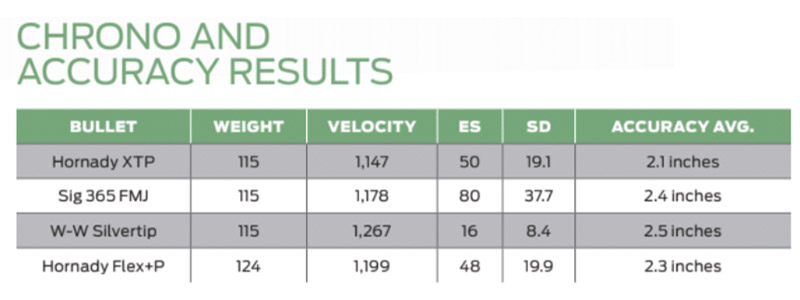
So, what’s the STK100 for? If you’re looking for a lightweight carry gun, it’s not the one. The extra weight puts it in second place to other pistols. If you want a heavier-than-polymer pistol for competition, again, not the one. You can easily get an all-steel competition pistol for USPSA or IDPA that runs 40 ounces or more.
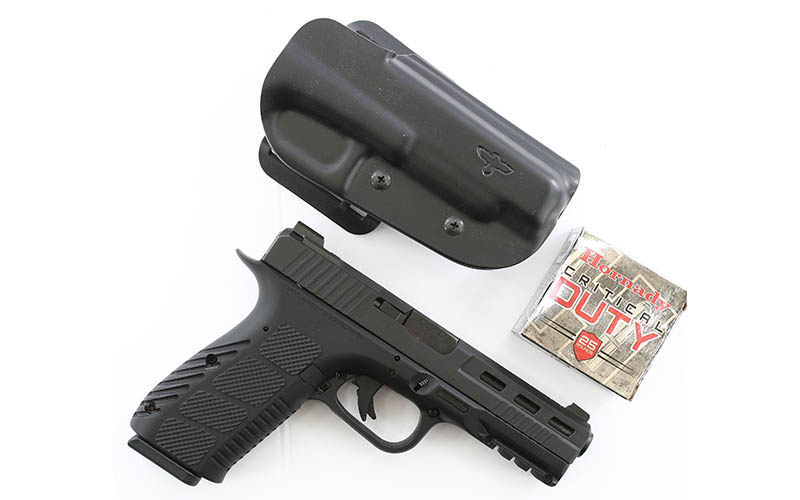
However, if you use competition as a means of staying in practice with your everyday carry gun, and you’re not necessarily a slave to “it has to be the lightest,” then the STK100 will fill the bill. A great trigger (a function of the stiffer frame assembly) and soft in recoil (weight and the tang) makes it fun to shoot in a match. And the extra ounces, while combating recoil, aren’t going to be noticed in a proper holster. And might I add, once again, if you’re not using a proper holster, you’re doing it wrong.
Disassembly? If you know how to do it to a Glock, you know how to do it to an STK100. If not, the process is easy to find.
Armscor has hit a home run with this one.

Editor's Note: This article originally appeared in the 2022 CCW special issue of Gun Digest the Magazine.
More Handgun Reviews:
- The Big Snake Is Back: 2021 Colt Anaconda Review
- The Grand Puissance: Springfield SA-35 Review
- Shadow Systems MR920 Review
- Completely Customizable: Sig P320 Review
- Turkish Take On The Czech Classic: SAR 2000 Review

Next Step: Get your FREE Printable Target Pack
Enhance your shooting precision with our 62 MOA Targets, perfect for rifles and handguns. Crafted in collaboration with Storm Tactical for accuracy and versatility.
Subscribe to the Gun Digest email newsletter and get your downloadable target pack sent straight to your inbox. Stay updated with the latest firearms info in the industry.

![Best Concealed Carry Guns In 2025 [Field Tested] Wilson Combat EDC X9S 1](https://gundigest.com/wp-content/uploads/Wilson-Combat-EDC-X9S-1-324x160.jpg)


![Best 9mm Carbine: Affordable PCCs [Tested] Ruger Carbine Shooting](https://gundigest.com/wp-content/uploads/Ruger-Carbine-Shooting-100x70.jpg)
![Best AR-15: Top Options Available Today [Field Tested] Harrington and Richardson PSA XM177E2 feature](https://gundigest.com/wp-content/uploads/Harrington-and-Richardson-PSA-XM177E2-feature-100x70.jpg)

I own the STK 100. I had for a while before I fired it. It keeps jamming. Being that it is brand new should I be taking it to a dealer to get fixed? I feel like the factory should fix it.
Please advise